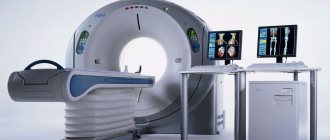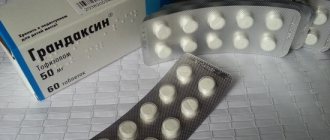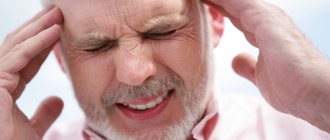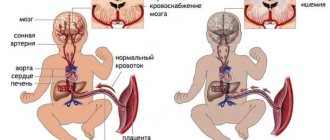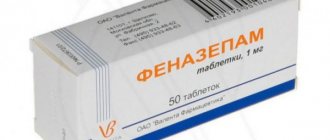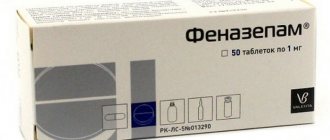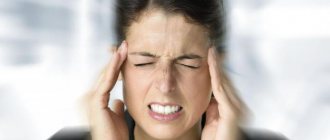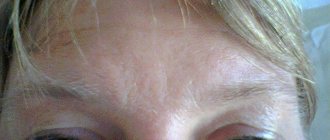Clinical picture of phenazepam poisoning
Phenazepam is a medicine that has the following properties: anticonvulsant (used in the treatment of epilepsy, alcoholic delirium), sedative, hypnotic (for insomnia caused by unmotivated anxiety), muscle relaxant (for muscle spasms). The drug is addictive; for the same effect, you need to increase the dose. At home, without medical supervision, an overdose can occur. The clinical picture develops in stages:
- Initial manifestations are similar to alcohol intoxication. After taking a high dose of medication, the first symptoms appear within 30 minutes. The patient is in a state similar to intoxication: he is incredibly happy, feels strong, fearless. The patient's speech is slurred and unclear. Coordination of movements is impaired. Symptoms of euphoria are replaced by drowsiness and apathy. The patient falls into a deep sleep. An objective examination reveals bradycardia (heart rate less than 60), increased salivation, the reaction of the pupils is lively, they are narrowed.
- In the second stage, the person falls into stupor - a superficial coma. The patient is unconscious. The main difference from a deep coma is that the reaction to pain is preserved. The pupils are constricted. There is vomiting, which threatens lung aspiration. Muscle reflexes and tone are reduced.
- Without medical help, the second stage quickly progresses to the third. The patient is in a deep coma and does not respond to external stimuli. Main symptoms: thread-like pulse, bradypnea (rare breathing), all reflexes are completely turned off. Impaired kidney and liver function occurs. Only correct and effective emergency measures can help the patient. The absence of medical intervention threatens to stop breathing, cardiac activity, and brain function.
- The fourth stage occurs only after adequate and timely treatment. It's called awakening. The person comes out of a coma, and lost systemic functions are gradually restored.
The presence of medications at home poses a direct threat to the child’s health. Often young children accidentally take pills out of curiosity. Grandmother, grandfather, and mother were prescribed the drug, the child was interested in the open cabinet, and trouble could not be avoided.
Acute drug poisoning in children is not uncommon. In children, drug overdose occurs more favorably than in older adults. The clinical picture is dominated by symptoms of functional disorders of the central nervous system: stupor, stupor, uncoordinated movements, hallucinatory disorders. As a result of hemodynamic instability, children return to normal faster than adults.
There are three degrees of phenazepam overdose:
- Easy. A small dose of the drug does not suppress higher nervous activity and is manifested by minor behavioral disturbances. The patient is sleeping. Decreased tendon reflexes, muscle hypotonia, and uncoordinated movements are noted.
- Moderate degree is an intermediate state between mild manifestations of poisoning and coma. The patient has impaired swallowing and cough reflex. On objective examination, the pupils are constricted and do not respond to light stimuli. Severe degree is characterized by agony, complete loss of vital functions. The patient exhibits pathological types of breathing, weak pulse, abnormally dilated pupils, decreased body temperature and blood pressure.
- Chronic poisoning is distinguished separately. The patient independently increases the dosage or number of phenazepam doses. First, trembling of the limbs, unmotivated weakness, attacks of nausea, depressive, anxious states, and insomnia appear. Over time, the clinical picture is supplemented by complaints of vomiting, epigastric pain, hallucinations, and convulsions.
Withdrawal syndrome in drug addiction
It is the withdrawal syndrome that becomes a powerful factor provoking further use of the drug. And in this sense, there is absolutely no difference from what physical dependence developed: from a prohibited illegal drug or a legal pharmaceutical drug, for example, phenazepam.
When reducing the dosage or stopping use, the addict will feel a number of painful symptoms relating to his physical and psychological well-being. All organs and systems of the patient’s body have already been restructured to work with the participation of the drug, and without it everything is disrupted, dysfunction, pain, psychological discomfort and disorders arise.
What is the lethal dose of the drug
It is recommended to prescribe the medicine only for strict indications. Intoxication with the drug can end in disaster. The lethal dose for phenazepam poisoning depends on many reasons:
- state of the human body (immunity reduced/normal);
- the presence of chronic pathology, its severity;
- addiction to the medication;
- number of tablets and person’s weight. The larger the mass and the fewer tablets, the better the prognosis;
- drinking alcoholic beverages. A history of alcohol consumption increases the risk of death by 2 or more times.
Symptoms of Phenazepam withdrawal syndrome
Phenazepam withdrawal syndrome is acute and can lead to suicide attempts due to the enormous stress on the psyche. After removing the tranquilizer from the body, the person feels unwell. At first he wants to take the pills again and suffers from depression. Then physical symptoms appear, including joint and muscle pain, migraine, nausea, diarrhea, vomiting, and fever.
Moreover, withdrawal syndrome may appear even when the dose is reduced by 2-3 times. Drug addicts do this to avoid withdrawal. In practice, this leads to serious consequences, including hearing impairment, weakness, insomnia, migraine, itchy skin, and lack of appetite. The symptoms are similar to the flu: sore throat, chills, high fever, weakness. In general, after completely stopping the medication, symptoms will persist for at least a week because over time the drug accumulates in the tissues and is eliminated gradually. If a drug addict has been taking pills for several months, it will take at least 30 days to remove the medication.
Antidote
Most powerful drugs have an antidote. The antidote to phenazepam is flumazenil. The drug blocks receptors that are affected by benzodiazepine drugs. Flumazenil is quickly eliminated from the body. In case of phenazepam poisoning, it is necessary to frequently administer its antidote, because benzodiazepine drugs have a long-lasting effect. The period of complete elimination of phenazepam is 36 hours. Flumazenil is used in anesthesiology (in therapeutic, diagnostic procedures, after recovery from anesthesia, in which benzodiazepines were used).
Emergency care begins with intravenous administration of 200-300 mcg of the drug. The maximum repeated dose is 1-2 mg. The antidote cannot be used in case of poisoning with cyclic antidepressants or individual intolerance to the drug.
After administering the medicine, you need to limit mental activity for one day, requiring high concentration and quick reaction.
The antidote should be used with caution in people suffering from epilepsy. After introduction into the body, Flumazenil blocks benzodiazepine receptors and increases the body’s convulsive readiness. An epileptic seizure can develop into another emergency condition - status epilepticus.
First aid for poisoning
Anyone can become poisoned through negligence with phenazepam or another drug. Measures for poisoning:
- Quickly dial the ambulance number; a person without medical education cannot cope on his own.
- Assess the condition of the victim. If the patient is conscious, try to induce a gag reflex. Give the patient a large amount of water (about 3 liters), a saturated solution of salt and sodium sulfate helps (it is advisable to drink more than a liter).
- Remove tight clothing (tie, jacket, shirt) and let fresh air into the room.
- You need to take activated carbon. For better absorption, crush the tablets and add to a glass of water. For drug poisoning, the following adsorbents are suitable: Enterosgel, Sorbex, white coal.
- Constantly monitor the condition of the victim. Ensure normal passage of air into the lungs. Turn the patient onto his side. In cardiopulmonary resuscitation, the triple Safar maneuver is used - throw back the head, extend the lower jaw, open the mouth so that the tongue does not sink in and interfere with breathing.
- If the patient is not breathing, unconscious, without a pulse, begin chest compressions and artificial ventilation until the ambulance arrives.
- Having an antidote simplifies the task. Doctors put in IVs with flumazelin. Support the functioning of the circulatory, respiratory, and central nervous systems. Symptomatic treatment is used.
Read also: Smoking in Italy 2020
Possible consequences
Any poisoning, drug or medication, threatens serious complications for the human body. It is easier to prevent a disease than to spend years restoring physiological functions.
Poisoning with the drug phenazepam causes the following consequences:
- Damage to the respiratory system (aspiration, secondary pneumonia).
- Cerebellar ataxia (impaired coordination of movements).
- Inflammatory kidney diseases (phenazepam is excreted by the kidneys, a high dosage of the drug causes an adverse effect on nephron function).
- Emotional instability (depression, anxiety).
- Liver damage.
- Long-term recovery may be accompanied by trophic disorders - bedsores.
Many diseases in psychiatry, neurology, and resuscitation are treated with phenazepam. If the dosage of the drug is increased or used incorrectly, acute poisoning may occur.
Phenazepam was created in the Soviet Union in the seventies of the last century, and was initially used exclusively for medical purposes, as a potent tranquilizer. At first it was used mainly in military medicine. The drug has a hypnotic, anticonvulsant and muscle relaxant effect. Physicians use phenazepam to treat epilepsy, insomnia, as well as depression and anxiety. Also used to treat alcohol withdrawal.
Long-term continuous use of phenazepam leads to severe dependence on the drug, which in turn leads to very serious disorders of the human nervous system. If in the initial stages of using the drug, drowsiness and a feeling of euphoria are observed, then after some time of continuous use of phenazepam, positive emotions will be replaced by negative ones. A person increasingly becomes irritable for no reason or reason. A state of depression and severe depression may develop. People who abuse phenazepam often suffer from anxiety attacks, hallucinations, and poor sleep. There may be thoughts of suicide.
Drug addicts use the “pure” drug quite rarely, due to its too unpredictable effect on the body. The drug either does not cause any “coming” and influx of emotions, or, on the contrary, “blows the roof off”. Most often, phenazepam is taken by drug addicts to relieve withdrawal symptoms, in the absence of other drugs, or simply to fall asleep.
The drug has a more powerful effect on the body of a drug addict than on someone who uses phenazepam exclusively for medicinal purposes.
So, with a large amount of the drug used, the inadequate state can last up to several hours. When mixing phenazepam with alcohol, an extreme degree of inadequacy is ensured (with external normal health). The condition is accompanied by a strong desire for communication and any activity. Can develop into aggression and anger. A mixture of alcohol and phenazepam can “cover” you for several days.
The drug has become widespread among drug addicts due to its low cost and relatively high effectiveness. This was also facilitated by the fact that phenazepam can be purchased with a regular prescription.
You need to get off the drug very carefully and gradually. Discontinuation of the drug is a very important step, so before stopping phenazepam, you should visit a doctor and undergo all the necessary tests. It is best to carry out the drug withdrawal procedure within the walls of the hospital, especially if there is no confidence that the patient will follow all the doctor’s instructions, but outpatient treatment is also possible. This method will allow the patient not to disrupt the normal rhythm of life.
1. Provocative test with pentobarbital
2. Method of phenobarbital equivalents (method suitable for outpatient treatment)
3. Saturating dose method.
The first two methods are aimed at determining the addict’s need for barbiturates, and the third method is designed to cause mild intoxication in the patient.
It is worth warning the addict in advance about the inevitable unpleasant sensations: malaise, anxiety, tachycardia, insomnia, nightmares, impaired coordination of movements.
These sensations can be so unbearable that some patients cannot stand it and quit treatment.
Read also: What was George 6’s name in childhood?
Phenazepam is considered a strong sleeping pill, which is good for helping you fall asleep, but the consequences of taking it can be disastrous.
New video course by R.V. Buzunov “How to improve sleep and overcome insomnia.”
Just an hour of pleasant viewing and you will learn how to solve the problem of poor sleep.
For example, improper use of phenazepam can cause sleep apnea. Decreased muscle tone and depression of the respiratory center cause the walls of the upper respiratory tract to close and make inhalations and exhalations more rare. This can lead to fatal consequences, especially in patients with sleep-disordered breathing (central, obstructive sleep apnea).
When taking phenazepam, daytime drowsiness, fatigue, decreased coordination and attention, and loss of orientation are often observed, which is especially dangerous for people whose work requires increased concentration and for drivers. Thus, about 20% of all road accidents are associated with drowsiness while driving.
Often, when taking phenazepam, addiction develops, and when you try to give up the medicine, a “withdrawal syndrome” occurs. At the same time, irritability and anxiety progress, and increased sensitivity to light and sounds increases.
Do you have insomnia? Call us and we will help you improve your sleep. Phones: 8-495-635-69-07 (08). You can also leave your number here and we will call you back.
Particularly severe consequences of taking phenazepam are observed in elderly patients, who may initially have impaired liver function. Treatment with this drug only worsens the sleep situation and provokes the emergence of additional health problems.
Deterioration of the condition is also possible with severe depression. Taking this drug can lead to a further decrease in mood and activity, which will aggravate the course of the disease.
Phenazepam is usually used for insomnia. However, it is a condition that has many causes.
If sleep disturbance occurs periodically and is associated with a shift work schedule, flights, “weekend insomnia,” then the first thing you should do is not take pills out of the medicine cabinet, but start observing sleep hygiene. Even if this is not enough, there are safer but more effective medications than phenazepam, such as melatonin preparations (Melaxen). By restoring biological rhythms, melaxen returns patients to full sleep. This drug is available and can be purchased without a prescription. At the same time, it does not have the same consequences of taking phenazepam; it does not affect muscles, breathing, sleep patterns and daytime activity.
For serious and long-term disorders, it may be necessary to prescribe more serious sleeping pills, but these are not benzodiazepines, but Z-group drugs. Sanval is famous among them; this drug does not lead to addiction and has fewer side effects, which reduces the risk of negative consequences of treatment. Sanval is available in pharmacies only with a prescription.
Attention! The problem of insomnia is not always solved with pills. Insomnia can be caused by psychological disorders. The Sleep Medicine Center employs a highly qualified psychotherapist who can find the causes of psychological discomfort and help get rid of them. You can make an appointment by phone and.
Other useful articles:
Calls are accepted from 8 to 20.00 Moscow time
Phenazepam is one of the most powerful tranquilizers of the benzodiazepine series. It is used in the treatment of hypochondriacal conditions, phobias, panic attacks, psychoses, neuroses, insomnia, alcoholic delirium, and convulsive syndrome. Treatment with Phenazepam is carried out exclusively as prescribed by a doctor and under his supervision, since unsystematic use of the drug can cause serious complications, one of which is an overdose.
Treatment of phenazepam addiction in St. Petersburg.
The drug treatment clinic at StopNarco in St. Petersburg organizes comprehensive treatment for phenazepam addiction, which is carried out in a certain order . However, before starting treatment, each patient undergoes an examination and consultation, the results of which allow specialists to select the most effective procedures and methods for treating phenazepam addiction in his case. This flexible approach to each client allows us to achieve sustainable results in the fight against this addiction. Highly qualified specialists of our institution have developed and apply their own methods in combination with existing proven technologies . The course of treatment for phenazepam has the following sequence:
- Diagnosis and consultation of the patient . This stage includes an examination and conversations with the patient by our specialists, this helps to identify all the subtleties of health and the course of drug addiction.
- Cleansing the addict's body . At this time, the body detoxifies from harmful substances and drug residues. This allows you to bring the patient’s blood composition back to normal and return him to good health.
- Medication course of treatment. At this stage, the drug phenazepam is completely withdrawn through the use of safe medications with similar effects. Also during this time, the patient undergoes therapy with useful pharmacological drugs that restore his health and normalize his psycho-emotional state. Also, if symptoms that were eliminated by phenazepam occur, alternative medications that do not cause side effects and addiction are selected for the patient.
- Rehabilitation program of psychotherapy . This is an extremely important and difficult stage in the treatment of phenazepam addiction. During this period, the patient and staff have to make a lot of efforts to effectively recover from this form of drug addiction.
Phenazepam is an inexpensive and extremely effective drug, and is often used without a medical prescription. However, addiction to phenazepam can only be eliminated in specialized clinics under the supervision and control of narcologists. The drug treatment clinic “StopNarko” in St. Petersburg is a medical institution that employs top-class specialists. Don’t let phenazepam addiction develop to a chronic stage - call us today and get a chance for a drug-free life. Our center has helped a very large number of patients, and your case will be no exception.
What dose of Phenazepam is needed for an overdose?
The dose of Phenazepam is selected by the doctor individually, taking into account the patient’s disease, his general condition, age and many other factors. So, for insomnia, Phenazepam is usually taken 30–40 minutes before bedtime at a dose of 0.5–1 mg. To relieve alcohol or drug withdrawal, the daily dose of Phenazepam is 2.5–5 mg. The maximum daily dose of the drug for patients suffering from epilepsy is 2.5–10 mg, divided into several doses at regular intervals. For some psychiatric diseases, for example, personality depersonalization, Phenazepam can be prescribed in very high daily doses (up to 20 mg), but such therapy is allowed only in a hospital setting.
The danger of Phenazepam is that in some cases even a slight excess of the therapeutic dose can lead to an overdose. A single dose of 10 mg of Phenazepam can cause severe poisoning with a fatal outcome.
It is unacceptable to use Phenazepam in combination with alcohol-containing products (drinks and medications), since alcohol potentiates the inhibitory effect on the central nervous system. As a result, taking even the correct dose can cause an overdose.
Drug withdrawal regimen
In order to prevent the development of a pathological syndrome, there are different methods for correctly stopping phenazepam. The simplest and most effective way is to gradually reduce the dosage. Experts recommend reducing the dose of the drug by 10% of the original every two weeks. Thus, you can completely stop taking the drug 5 months after the start of gradual withdrawal.
There are also accelerated regimens that include the prescription of drugs that can “cover up” the absence of phenazepam. These regimens are selected by the attending physician, depending on the pathology for which phenazepam was prescribed.
Signs of overdose
The severity of an overdose of Phenazepam depends on the number of tablets taken, the time interval between taking them, as well as their combination with alcohol or other drugs.
Mild and moderate overdoses are characterized by:
- confusion;
- drowsiness followed by deep sleep;
- decreased blood pressure (BP);
- heart rhythm disturbances;
- constipation or, conversely, diarrhea;
- nausea and vomiting;
- increased salivation (hypersalivation);
- acute urinary retention or involuntary urination.
If the maximum permissible dose is significantly exceeded, severe intoxication develops, its signs:
- shallow irregular breathing;
- convulsions;
- severe cardiovascular failure;
- coma.
Read also: Tablets for severe cough with bronchitis
A general blood test reveals thrombocytopenia, anemia, leukopenia and neutropenia. Often, a severe overdose of Phenazepam causes kidney damage with the development of acute renal failure.
First aid for an overdose of Phenazepam
First aid for an overdose of Phenazepam should be provided as quickly as possible. If the victim is conscious:
- Rinse the stomach: drink about 1 liter of hypertonic salt solution (2-3 tablespoons of table salt per 1 liter of water), then, pressing on the root of the tongue, induce vomiting.
- Take enterosorbent (Smecta, Activated carbon, Enterosgel, etc.).
If the victim is unconscious, he must be turned on his side and ensure that he remains in this position until the ambulance arrives - this will prevent obstruction of the airways by vomit or a sunken tongue.
When is medical help needed?
In case of an overdose of Phenazepam, specialized medical care is necessary in 100% of cases; the sooner it is provided, the greater the chance of a successful outcome. Therefore, as soon as the fact of an overdose of Phenazepam is established, an ambulance should be called, and only then begin first aid.
Patients are subject to mandatory hospitalization in the toxicology department of the hospital. Treatment includes the following measures:
- Gastric lavage using a gastric tube.
- Intravenous administration of Flumazenil. It should be borne in mind that this drug is contraindicated in patients suffering from epilepsy or with combined poisoning with Phenazepam and proconvulsants (Amitriptyline, Aminophylline). In these cases, forced diuresis with alkalization of urine is indicated.
- Symptomatic treatment aimed at maintaining vital functions: drugs are prescribed that stimulate the central nervous system, supporting respiratory and cardiovascular activity.
Rehabilitation after using phenazepam.
As stated above, rehabilitation from phenazepam is an extremely painstaking and complex treatment process. This requires a professional and flexible approach. The rehabilitation center in St. Petersburg “StopNarco” in its rehabilitation program uses an integrated approach to the treatment of phenazepamide addicts, which consists of the simultaneous use of a 12-step recovery program, the most modern medication techniques, and high-quality psychotherapy. The peculiarity of treating addiction to this drug is the need to eliminate both physical addiction and uncontrollable psychological attraction. For this purpose, our staff includes highly qualified psychologists and psychotherapists. However, the rehabilitation process requires the presence of competent rehabilitation specialists who monitor and control the overall recovery. Also, if necessary, they can adjust the treatment program, which allows them to use a flexible, adaptive approach to each patient.
Our drug rehabilitation center “StopNarko” in St. Petersburg is equipped with all the necessary conditions: cozy rooms, modern medical equipment, high-quality kitchen, recreation areas, rooms for group and personal therapy. All this allows our patients to feel as comfortable as possible during the treatment process from phenazepam.
Independent attempts to influence or treat a phenazepam addict will most likely only lead to aggravation of the situation. There is a high probability of aggravating the health status of the drug addict, causing irreversible changes in his physical and mental health, triggering a psychiatric diagnosis, as well as death.
As soon as you realize that there is a problem with addiction to phenazepam, you should immediately seek urgent drug treatment help from experienced specialists at the StopNarco clinic in St. Petersburg. People's lives are important to us, so we will be happy to help you or your relative save a life, get it back on track and get freedom from any form of addiction. You can call us at any time of the day.
Possible consequences
The body's recovery is slow. Over a long period, an unsteady gait, impaired coordination of movements, and a depressive state caused by toxic and hypoxic encephalopathy are observed. A frequent consequence of an overdose of Phenozepam is persistent impairment of the functions of the liver and/or kidneys, up to the development of their failure.
Video from YouTube on the topic of the article:
Education: graduated from the Tashkent State Medical Institute with a degree in general medicine in 1991. Repeatedly took advanced training courses.
Work experience: anesthesiologist-resuscitator at a city maternity complex, resuscitator at the hemodialysis department.
The information is generalized and is provided for informational purposes. At the first signs of illness, consult a doctor. Self-medication is dangerous to health!
The first vibrator was invented in the 19th century. It was powered by a steam engine and was intended to treat female hysteria.
The cough medicine “Terpinkod” is one of the top sellers, not at all because of its medicinal properties.
When we sneeze, our body stops working completely. Even the heart stops.
Over the course of a lifetime, the average person produces no less than two large pools of saliva.
A person taking antidepressants will, in most cases, become depressed again. If a person has coped with depression on his own, he has every chance to forget about this condition forever.
American scientists conducted experiments on mice and came to the conclusion that watermelon juice prevents the development of vascular atherosclerosis. One group of mice drank plain water, and the second group drank watermelon juice. As a result, the vessels of the second group were free of cholesterol plaques.
In 5% of patients, the antidepressant Clomipramine causes orgasm.
Research shows that women who drink several glasses of beer or wine per week have an increased risk of developing breast cancer.
You are more likely to break your neck if you fall off a donkey than if you fall off a horse. Just don't try to refute this statement.
In an effort to get the patient out, doctors often go too far. For example, a certain Charles Jensen in the period from 1954 to 1994. survived more than 900 operations to remove tumors.
A job that a person doesn’t like is much more harmful to his psyche than no job at all.
More than $500 million a year is spent on allergy medications in the United States alone. Do you still believe that a way to finally defeat allergies will be found?
Even if a person's heart does not beat, he can still live for a long period of time, as the Norwegian fisherman Jan Revsdal demonstrated to us. His “engine” stopped for 4 hours after a fisherman got lost and fell asleep in the snow.
Smiling just twice a day can lower your blood pressure and reduce the risk of heart attacks and strokes.
Many drugs were initially marketed as medicines. Heroin, for example, was originally brought to market as a cure for children's coughs. And cocaine was recommended by doctors as an anesthesia and as a means of increasing endurance.
The number of employees engaged in office work has increased significantly. This trend is especially true in large cities. Office work attracts men and women.
How to get off
The question is not easy. This medicine is controversial. A serious side effect is withdrawal syndrome. There is a lot of advice on the Internet on how to get off Phenazepam, but this should be done under the supervision of a doctor. After all, after taking the medicine for a long time, a strong dependence occurs, which is accompanied by neurotic disorders.
If you sharply reduce the dosage of a tranquilizer or completely stop taking it, the patient will experience insomnia, severe irritability, increased sweating, depression, photophobia, tachycardia, convulsions, acute psychosis, and perception disorders. Therefore, it is important to consult with your doctor on how best to start withdrawing from this tranquilizer, and before taking it, find out whether there are more effective and safe analogues.
When depression comes, the world around is destroyed, there is no physical and moral strength, you have to turn to doctors for help. Typically, patients with mental disorders are treated by psychotherapists or psychiatrists.
In addition to psychotherapy, they prescribe medication, which includes antidepressants, tranquilizers, sedatives and psychotropic drugs. We will tell you about Phenazepam and how to get off it in the article below.
Description
How to get rid of Phenazepam? What kind of drug is this anyway? It belongs to the group of benzodiazepine tranquilizers. Capable of having sedative, hypnotic, anticonvulsant, and anxiolytic effects.
Its effect is due to its influence on the limbic system, which manifests itself in patients in the form of a decrease in tension, anxiety, restlessness, and phobias. Therefore, it causes addiction in the person taking it.
As a result, cancellation difficulties arise.
The calming effect is due to the fact that Phenazepam reduces symptoms of neurotic origin, affecting the reticular formation of the brain stem. Eliminates vegetative manifestations, emotional stress, anxiety, worry and fears.
After administration, it is absorbed in the gastrointestinal tract, and metabolism occurs in the liver. Excreted by the kidneys.


